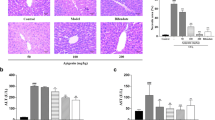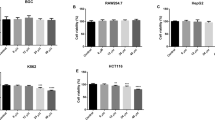Abstract
We speculated that lipid peroxidation induced by tert-butyl hydroperoxide (t-BHP) in liver is closely linked with the metabolism mediated by CYPs. In this study, we have examined the effect of Perilla leaf extract (PLE) on CYPs using 7-ethoxyresorufin-O-deethylase (EROD, indicator of CYP1A1), 7-methoxyresorufin-O-demethylase (MROD, indicator of CYP1A2), erythromycin N-demethylase (ERDM, indicator of CYP3A), and p-nitrophenol hydroxylase (PNPH, indicator of CYP2E1) in rat liver. Rats orally pretreated with PLE (250, 500, and 1,000 mg/kg b.w.) for 5 days were administered with a single i.p. dose of t-BHP (0.5 mmol/kg). Kinetic analysis of CYP1A1/2 activities in t-BHP-treated liver demonstrated that PLE inhibits the enzyme activities by competitive and noncompetitive inhibitions. The pretreatment with PLE decreased the expression of CYP1A1/2 mRNA and protein compared with t-BHP treatment alone. A Phase II enzyme, heme oxygenase-1 (HO-1), is involved in hepatoprotection against oxidative damage, and we confirmed that PLE increases the levels of HO-1 mRNA and protein, as well as its activity in t-BHP-induced liver damage. PLE administration resulted in enhanced nuclear translocation and ARE binding of NF-E2-related factor 2. These findings suggest that PLE protects against t-BHP-induced hepatotoxicity through modulated activity and expression of selective CYPs, and ARE-driven induction of HO-1 expression and its activity.








Similar content being viewed by others
Abbreviations
- ARE:
-
Antioxidant response element
- CYPs:
-
Cytochrome P450s
- EROD:
-
7-Ethoxyresorufin O-deethylase
- ERDM:
-
Erythromycin N-demethylase
- HO-1:
-
Heme oxygenase 1
- MROD:
-
7-Methoxyresorufin O-demethylase
- NADPH:
-
β-Nicotinamide adenine dinucleotide phosphate reduced form
- Nrf2:
-
NF-E2-related factor 2
- PLE:
-
Perilla leaf extract
- PNPH:
-
p-Nitrophenol hydroxylase
- ROS:
-
Reactive oxygen species
- t-BHP:
-
Tert-butyl hydroperoxide
References
Alam J, Cook JL (2003) Transcriptional regulation of the heme oxygenase-1 gene via the stress response element pathway. Curr Pharm Des 9:2499–2511
Barouki R, Morel Y (2001) Repression of cytochrome P450 1A1 gene expression by oxidative stress: mechanisms and biological implications. Biochem Pharmacol 61:511–516
Bernhardt R (1996) Cytochrome P450: Structure, function, and generation of reactive oxygen species. Reviews of physiology biochemistry and pharmacology, vol 127. Springer, Berlin, pp 137–221
Bondy SC, Naderi S (1994) Contribution of hepatic cytochrome-P450 systems to the generation of reactive oxygen species. Biochem Pharmacol 48:155–159
Chan KH, Ng MKC, Stocker R (2011) Haem oxygenase-I and cardiovascular disease: mechanisms and therapeutic potential. Clin Sci 120:493–504
Chen Q, Galleano M, Cederbaum AI (1998) Cytotoxicity and apoptosis produced by arachidonic acid in HepG2 cells overexpressing human cytochrome P-4502E1. Alcohol Clin Exp Res 22:782–784
Choi SY, Lee KJ, Kim HG, Han EH, Chung YC, Sung NJ, Jeong HG (2006) Protective effect of the coffee diterpenes kahweol and cafestol on tert-butyl hydroperoxide-induced oxidative hepatotoxicity. Bull Korean Chem Soc 27:1386–1392
Chun KS, Keum YS, Han SS, Song YS, Kim SH, Surh YJ (2003) Curcumin inhibits phorbol ester-induced expression of cyclooxygenase-2 in mouse skin through suppression of extracellular signal-regulated kinase activity and NF-kappa B activation. Carcinogenesis 24:1515–1524
Droge W (2002) Free radicals in the physiological control of cell function. Physiol Rev 82:47–95
Fesen MR, Pommier Y, Leteurtre F, Hiroguchi S, Yung J, Kohn KW (1994) Inhibition of Hiv-1 integrase by flavones, caffeic acid phenethyl ester (Cape) and related-compounds. Biochem Pharmacol 48:595–608
Gyamfi MA, Hokama N, Oppong-Boachie K, Aniya Y (2000) Inhibitory effects of the medicinal herb, Thonningia sanguinea, on liver drug metabolizing enzymes of rats. Hum Exp Toxicol 19:623–631
Han SS, Keum YS, Seo HJ, Chun KS, Lee SS, Surh YJ (2001) Capsaicin suppresses phorbol ester-induced activation of NF-kappa B/Rel and AP-1 transcription factors in mouse epidermis. Cancer Lett 164:119–126
Harman AW (1985) The effectiveness of antioxidants in reducing paracetamol-induced damage subsequent to paracetamol activation. Res Commun Chem Pathol Pharmacol 49:215–228
Hogberg J, Orrenius S, Obrien PJ (1975) Further studies on lipid-peroxide formation in isolated hepatocytes. Eur J Biochem 59:449–455
Ishii T, Itoh K, Takahashi S, Sato H, Yanagawa T, Katoh Y, Bannai S, Yamamoto M (2000) Transcription factor Nrf2 coordinately regulates a group of oxidative stress-inducible genes in macrophages. J Biol Chem 275:16023–16029
Johnson AA, Marchand C, Pommier Y (2004) HIV-1 integrase inhibitors: a decade of research and two drugs in clinical trial. Curr Top Med Chem 4:1059–1077
Kang KW, Lee SJ, Kim SG (2005) Molecular mechanism of Nrf2 activation by oxidative stress. Antioxid Redox Signal 7:1664–1673
Kapitulnik J (2004) Bilirubin: an endogenous product of heme degradation with both cytotoxic and cytoprotective properties. Mol Pharmacol 66:773–779
Kappus H (1993) Metabolic reactions: role of cytochrome P-450 in the formation of reactive oxygen species. In: Schenkman J, Greim H (eds) Cytochrome P450, vol 105. Springer, Berlin, pp 145–154
Kim MK, Lee HS, Kim EJ, Won NH, Chi YM, Kim BC, Lee KW (2007) Protective effect of aqueous extract of Perilla frutescens on tert-butyl hydroperoxide-induced oxidative hepatotoxicity in rats. Food Chem Toxicol 45:1738–1744
Koop DR (1986) Hydroxylation of p-nitrophenol by rabbit ethanol-inducible cytochrome P-450 isozyme 3a. Mol Pharmacol 29:399–404
Lee KJ, Choi CY, Chung YC, Kim YS, Ryu SY, Roh SH, Jeong HG (2004) Protective effect of saponins derived from roots of Platycodon grandiflorum on tert-butyl hydroperoxide-induced oxidative hepatotoxicity. Toxicol Lett 147:271–282
Liu CL, Wang JM, Chu CY, Cheng MT, Tseng TH (2002) In vivo protective effect of protocatechuic acid on tert-butyl hydroperoxide-induced rat hepatotoxicity. Food Chem Toxicol 40:635–641
Lubet RA, Mayer RT, Cameron JW, Nims RW, Burke MD, Wolff T, Guengerich FP (1985) Dealkylation of pentoxyresorufin—a rapid and sensitive assay for measuring induction of cytochrome(S)-P-450 by phenobarbital and other xenobiotics in the rat. Arch Biochem Biophys 238:43–48
Marques V, Farah A (2009) Chlorogenic acids and related compounds in medicinal plants and infusions. Food Chem 113:1370–1376
McMahon M, Itoh K, Yamamoto M, Chanas SA, Henderson CJ, McLellan LI, Wolf CR, Cavin C, Hayes JD (2001) The cap ‘n’ collar basic leucine zipper transcription factor Nrf2 (NF-E2 p45-related factor 2) controls both constitutive and inducible expression of intestinal detoxification and glutathione biosynthetic enzymes. Cancer Res 61:3299–3307
Morse D, Choi AMK (2002) Heme oxygenase-1—the “emerging molecule” has arrived. Am J Respir Cell Mol Biol 27:8–16
Nagai F, Kato E, Tamura H (2004) Oxidative stress induces GSTP1 and CYP3A4 expression in the human erythroleukemia cell line, K562. Biol Pharm Bull 27:492–495
Nardini M, Natella F, Gentili V, DiFelice M, Scaccini C (1997) Effect of caffeic acid dietary supplementation on the antioxidant defense system in rat: an in vivo study. Arch Biochem Biophys 342:157–160
Nash T (1953) The colorimetric estimation of formaldehyde by means of the Hantzsch reaction. Biochem J 55:416–421
Park HY, Nam MH, Lee HS, Jun W, Hendrich S, Lee KW (2010) Isolation of caffeic acid from Perilla frutescens and its role in enhancing gamma-glutamylcysteine synthetase activity and glutathione level. Food Chem 119:724–730
Pohl RJ, Fouts JR (1980) A rapid method for assaying the metabolism of 7-ethoxyresorufin by microsomal subcellular-fractions. Anal Biochem 107:150–155
Pugazhenthi S, Akhov L, Selvaraj G, Wang M, Alam J (2007) Regulation of heme oxygenase-1 expression by demethoxy curcuminoids through Nrf2 by a PI3-kinase/Akt-mediated pathway in mouse beta-cells. Am J Physiol Endocrinol Metab 293:E645–E655
Raju VS, Maines MD (1996) Renal ischemia/reperfusion up-regulates heme oxygenase-1 (HSP32) expression and increases cGMP in rat heart. J Pharmacol Exp Ther 277:1814–1822
Reed JR, Cawley GF, Backes WL (2011) Inhibition of cytochrome P450 1A2-mediated metabolism and production of reactive oxygen species by heme oxygenase-1 in rat liver microsomes. Drug Metab Lett 5:6–16
Rush GF, Gorski JR, Ripple MG, Sowinski J, Bugelski P, Hewitt WR (1985) Organic hydroperoxide-induced lipid-peroxidation and cell-death in isolated hepatocytes. Toxicol Appl Pharmacol 78:473–483
Rushmore TH, Kong ANT (2002) Pharmacogenomics, regulation and signaling pathways of phase I and II drug metabolizing enzymes. Curr Drug Metab 3:481–490
Talalay P, Fahey JW (2001) Phytochemicals from cruciferous plants protect against cancer by modulating carcinogen metabolism. J Nutr 131:3027s–3033s
Thornalley PJ, Trotta RJ, Stern A (1983) Free-radical involvement in the oxidative phenomena induced by tert-butyl hydroperoxide in erythrocytes. Biochim Biophys Acta 759:16–22
Ueda H, Yamazaki C, Yamazaki M (2002) Luteolin as an anti-inflammatory and anti-allergic constituent of Perilla frutescens. Biol Pharm Bull 25:1197–1202
Valentao P, Carvalho M, Carvalho F, Fernandes E, das Neves RP, Pereira ML, Andrade PB, Seabra RM, Bastos ML (2004) Hypericum androsaemum infusion increases tert-butyl hydroperoxide-induced mice hepatotoxicity in vivo. J Ethnopharmacol 94:345–351
Yang SY, Hong CO, Lee H, Park SY, Park BG, Lee KW (2012) Protective effect of extracts of Perilla frutescens treated with sucrose on tert-butyl hydroperoxide-induced oxidative hepatotoxicity in vitro and in vivo. Food Chem 133:337–343
Yang SY, Hong CO, Lee GP, Kim CT, Lee KW (2013) The hepatoprotection of caffeic acid and rosmarinic acid, major compounds of Perilla frutescens, against t-BHP-induced oxidative liver damage. Food Chem Toxicol 55:92–99
Yen GC, Yeh CT, Chen YJ (2004) Protective effect of mesona procumbens against tert-butyl hydroperoxide-induced acute hepatic damage in rats. J Agric Food Chem 52:4121–4127
Zhao CR, Gao ZH, Qu XJ (2010) Nrf2-ARE signaling pathway and natural products for cancer chemoprevention. Cancer Epidemiol 34:523–533
Acknowledgments
This research was supported by High Value-added Food Technology Development Program (111021-03-HD110) and Fishery Commercialization Technology Development Program (113007-03-SB010) for Korea Institute of Planning and Evaluation for Technology in Food, Agriculture, Forestry and Fisheries (iPET). The authors also thank the Korea University—CJ Food Safety Center (Seoul, South Korea) for provision of equipment and facilities.
Author information
Authors and Affiliations
Corresponding author
Additional information
Jeong Han Kang and Sung-Yong Yang have equally contributed this work and should be considered as co-first authors.
Rights and permissions
About this article
Cite this article
Kang, J.H., Yang, SY., Ha, J. et al. Perilla frutescens modulates CYP1A1/2 and HO-1 and activates Nrf2 in oxidative stress-induced hepatotoxicity. J Korean Soc Appl Biol Chem 58, 305–315 (2015). https://doi.org/10.1007/s13765-015-0044-8
Received:
Accepted:
Published:
Issue Date:
DOI: https://doi.org/10.1007/s13765-015-0044-8




